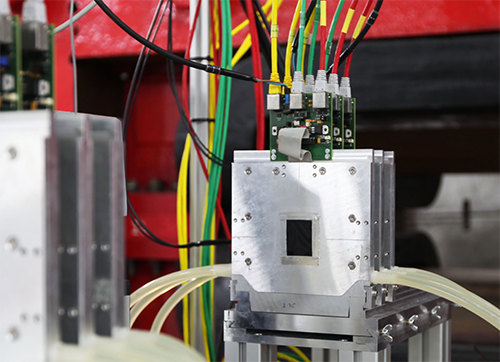
Probing future detectors
Barbara Warmbein (DESY), 27/05/2016

One of the existing telescopes being set up for tests of the ATLAS ITK in a test beam at DESY. (Image: DESY)
Some tools are so good that everybody wants one. Ever since the AIDA-forerunner project EUDET created the first versatile, precise and plug- and-play pixel-based beam telescope to probe detector components in test beams nine years ago, the operators and users of these test beams have been trying to get hold of one of their own. To this end, the seventh beam telescope of this series will be built under WP 15 for AIDA-2020 and it will take up residence at CERN.
A beam telescope is a tool that works as a reference for any small detector prototype to be tested by taking data itself. The AIDA-2020 pixel telescope consists of six plates equipped with silicon pixel sensors as well as a complete "Trigger Logic Unit.” The test object sits right in the middle of these six plates. With the highly accurate spatial resolution of the telescope’s detectors (down to 2 micron) the paths of passing particles from the test beam can be followed precisely. With this precise information users can easily verify detector performance using the telescope as a reference. But there is more to the tests than determining where something happened: quality.
“The telescope helps determine the homogeneity of your detector sensor and thus lets you understand your sensor very well down to micron level,” explains Marcel Stanitzki from the German laboratory DESY, one of the work package (WP) coordinators.
It’s the "Trigger Logic Unit” that makes the telescope so versatile and thus so desirable. The unit makes it possible to send trigger signals to any particle detector with only few adaptations. No need to tweak logics, software or electronics – users put their detector in, connect it, and if their data is different from the telescope’s they need to understand why and potentially go back to the drawing board.
The AIDA-2020 beam telescope is being assembled at DESY with the MIMOSA26 sensors coming from IPHC Strasbourg and the mechanical structure from DESY itself. It is scheduled to be completed in summer 2016, and will then be tested for functionality and shipped to CERN to start its new life as the resident AIDA-2020 beam telescope for the CERN- Proton Synchrotron test beam. While most of its time is likely to be used by upgrades of the LHC, the first customers in the queue are the architects of a future CLIC detector. They will test the CLICpix sensor at the end of September.
Six other telescopes have already been built and are in permanent use at labs like SLAC, DESY (which has two), CERN (which already has two, one of which exclusively for ATLAS) and the University of Bonn; some of them change places depending on where they are needed. With lots of detector R&D on the horizon for the high-luminosity LHC, many developers will want to test their devices in the proton beam of CERN’s Proton Synchrotron, so it was decided to make it a permanent infrastructure under AIDA-2020.
